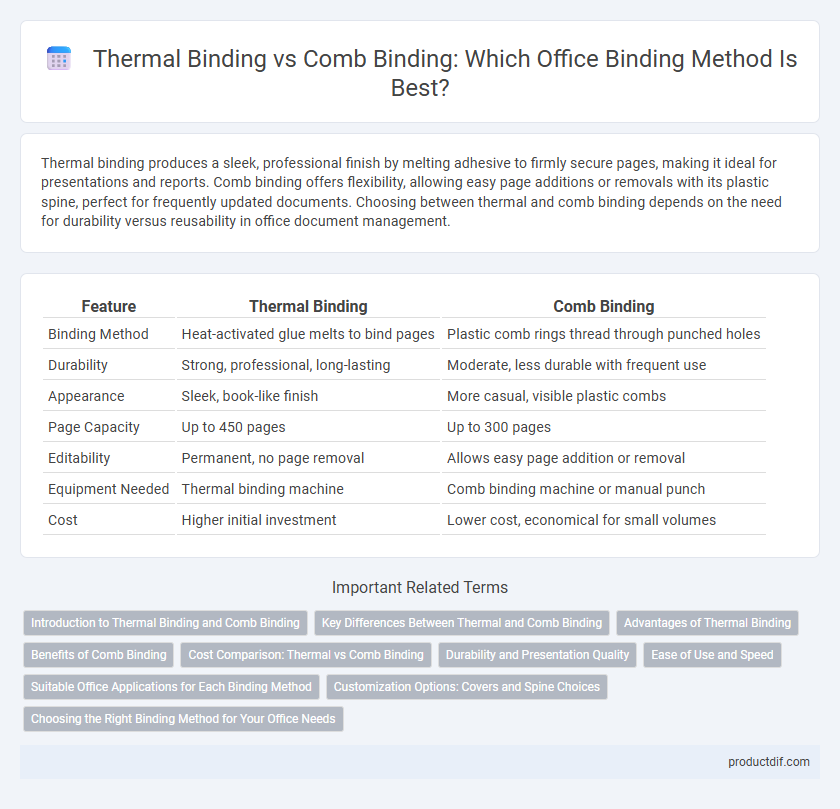Thermal binding produces a sleek, professional finish by melting adhesive to firmly secure pages, making it ideal for presentations and reports. Comb binding offers flexibility, allowing easy page additions or removals with its plastic spine, perfect for frequently updated documents. Choosing between thermal and comb binding depends on the need for durability versus reusability in office document management.
Table of Comparison
| Feature | Thermal Binding | Comb Binding |
|---|---|---|
| Binding Method | Heat-activated glue melts to bind pages | Plastic comb rings thread through punched holes |
| Durability | Strong, professional, long-lasting | Moderate, less durable with frequent use |
| Appearance | Sleek, book-like finish | More casual, visible plastic combs |
| Page Capacity | Up to 450 pages | Up to 300 pages |
| Editability | Permanent, no page removal | Allows easy page addition or removal |
| Equipment Needed | Thermal binding machine | Comb binding machine or manual punch |
| Cost | Higher initial investment | Lower cost, economical for small volumes |
Introduction to Thermal Binding and Comb Binding
Thermal binding uses heat to seal pages within a pre-glued spine, creating a sleek, professional finish ideal for reports and presentations. Comb binding involves plastic spines with multiple teeth that fit through rectangular holes punched along the document edge, allowing easy page addition or removal. Both methods offer durable document organization but differ in appearance, flexibility, and cost-effectiveness.
Key Differences Between Thermal and Comb Binding
Thermal binding uses heat to fuse adhesive into the spine of a document, creating a sleek, professional finish ideal for presentations and reports, while comb binding employs plastic spines with flexible rings that allow easy page addition or removal, making it convenient for ongoing projects. Thermal binding offers a more durable and polished appearance but is less customizable after binding, whereas comb binding provides versatility and quick editing capabilities at the expense of a less formal look. Choosing between thermal and comb binding depends on the need for durability versus flexibility in office document management.
Advantages of Thermal Binding
Thermal binding offers a professional, polished finish ideal for presentations, enhancing document durability with a strong, glue-based spine that secures pages better than comb binding. Unlike comb binding, thermal binding enables full-edge printing without holes, maintaining a sleek and clean appearance for reports and proposals. This method also supports thicker documents efficiently, making it suitable for comprehensive manuals and portfolios.
Benefits of Comb Binding
Comb binding offers flexible document editing by allowing easy addition or removal of pages without damaging the spine. Its durable plastic combs securely hold up to 425 sheets, making it ideal for thick reports and presentations. This binding method also enables documents to lay flat when open, enhancing readability and professional appearance.
Cost Comparison: Thermal vs Comb Binding
Thermal binding typically incurs higher upfront costs due to specialized machines and thermal covers but offers a polished, professional finish ideal for presentations and reports. Comb binding, by contrast, is more cost-effective with lower equipment and consumable expenses, making it suitable for frequent, everyday document assembly. Businesses balancing budget constraints with presentation quality often choose comb binding for economy and thermal binding for premium aesthetics.
Durability and Presentation Quality
Thermal binding offers superior durability with a clean, professional finish ideal for formal presentations, securing pages firmly without visible punches or clips. Comb binding allows for easy updating and page replacement but is less robust, with exposed plastic spines that may wear or break over time. Thermal binding enhances presentation quality with a sleek, polished appearance, while comb binding provides flexibility at the expense of long-term durability and aesthetics.
Ease of Use and Speed
Thermal binding offers a sleek, professional finish by quickly melting adhesive to secure pages, making it ideal for fast project completion without manual adjustments. Comb binding allows easy insertion and removal of pages, providing greater flexibility but requiring more time to set up due to manual alignment of the comb. Both methods cater to different office needs, balancing speed with ease of customization depending on document requirements.
Suitable Office Applications for Each Binding Method
Thermal binding is ideal for professional reports, presentations, and client proposals in office settings requiring a polished, book-like finish with durable, high-quality adhesion. Comb binding suits internal documents, manuals, and training materials where easy editing, page removal, and cost-efficiency are priorities. Offices handling varied document types often utilize thermal binding for final copies and comb binding for drafts or frequently updated files.
Customization Options: Covers and Spine Choices
Thermal binding offers sleek, professional-looking covers with customizable spine widths that accommodate varying document thicknesses, enhancing presentation quality. Comb binding provides flexible cover materials and a wide range of spine sizes, allowing for easy additions or removals of pages. Both options deliver versatile customization to suit different project requirements and aesthetic preferences.
Choosing the Right Binding Method for Your Office Needs
Thermal binding provides a clean, professional finish ideal for presenting important reports and proposals, while comb binding offers flexibility with easy editing and page replacement, making it suitable for frequently updated documents. Consider the document's purpose, presentation style, and frequency of changes when selecting between thermal and comb binding to ensure optimal functionality and appearance. For long-term durability and a sleek look, thermal binding is preferred; for cost-effectiveness and versatility, comb binding remains a popular choice in office settings.
Thermal Binding vs Comb Binding Infographic

 productdif.com
productdif.com